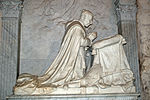Joaquín Bilbao
Joaquín Bilbao Martínez ( August 27, 1864 - January 30, 1934) [1] was a Spanish sculptor. He was the brother of the painter Gonzalo Bilbao.[2] He is best known for his work of the equestrian statue of Ferdinand III of Castile that is located in the Plaza Nueva, Seville, opposite the Town Hall.[3]

Early life

Joaquín began his studies at the Colegio San Alberto Magno. He studied Baccalaureate at the Provincial Institute.[1] During his high school education, he enrolled with his brother Gonzalo in drawing and watercolor classes under Professor Pedro Vega.[1] In 1881, upon finishing the Baccalaureate he enrolled in the Faculty of Law of the old Literary University of Seville. He finished his law studies in 1887. In 1890, he started working at the law firm of Manuel de Bedmar y Escudero. At the age of 29 he left the legal profession to devote himself completely to sculpture.[1]
Professional life
In 1900 he moved to Paris, where he attended his Académie des Beaux-Arts for four years. During that time, he also made trips to Belgium , Netherlands , Germany and England. During his stay abroad, he did not lose contact with the Academia de Bellas Artes (Seville) and with the Spanish national exhibitions.[1] In Netherlands and Belgium, he learned from the work of Constantin Meunier.[4] He returned to Seville in 1904. In October of that year, the Academia de Bellas Artes (Seville) named Joaquín as a member of Sculpture of the Provincial Commission of Historical and Artistic Monuments.[5][4][6]
In 1909 he moved to Toledo and became professor at the School of Arts and Crafts of Toledo. In this city he was also conservator of the Casa Museo del Greco.[4] In 1902 he was appointed Ordinary Commander of the Civil Order of Alfonso XII.[5] In 1912 he returned to his hometown, where he remained, except for sporadic trips.[1]
From 1914 to 1919 he had a disciple in his workshop Enrique Pérez Comendador, who made a bronze bust of his teacher.[7]
Literature
- Moriana, Mario Gómez (2010). El escultor sevillano Joaquín Bilbao Martínez, 1864-1934 (in Spanish). Diputación de Sevilla. ISBN 978-84-7798-282-1.
- Santalo, León Carlos Álvarez (1999). Las cofradías de Sevilla en el siglo de las crisis (in Spanish). Universidad de Sevilla. ISBN 978-84-472-0510-3.
External links
| Wikimedia Commons has media related to Joaquín Bilbao Martínez. |
- "Joaquín Bilbao Martínez | Real Academia de la Historia". dbe.rah.es. DBE.
References
- Moriana, Mario Gómez (2010). El escultor sevillano Joaquín Bilbao Martínez, 1864-1934 (in Spanish). Diputación de Sevilla. ISBN 978-84-7798-282-1.
- Sevilla, Diario de (11 December 2007). "El hermano olvidado de Gonzalo". Diario de Sevilla (in Spanish).
- Tilburg, Kees van (6 April 2016). "Equestrian statue of Fernando lll in Sevilla Spain". Equestrian statues. Retrieved 24 July 2020.
- "Bilbao y Martínez, Joaquín". Benezit Dictionary of Artists. Oxford University Press. 31 October 2011. doi:10.1093/benz/9780199773787.article.B00019714.
- Santalo, León Carlos Álvarez (1999). Las cofradías de Sevilla en el siglo de las crisis (in Spanish). Universidad de Sevilla. p. 234. ISBN 978-84-472-0510-3.
- Aguilar, Inmaculada Concepción Rodríguez (2000). Arte y cultura en la prensa: la pintura sevillana (1900-1936) (in Spanish). Universidad de Sevilla. p. 642. ISBN 9788447205769.
- Gómez Moriana 2010, p. 130.